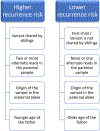Parental mosaicism for apparent de novo genetic variants: Scope, detection, and counseling challenges
- PMID: 35394072
- PMCID: PMC9995893
- DOI: 10.1002/pd.6144
Parental mosaicism for apparent de novo genetic variants: Scope, detection, and counseling challenges
Abstract
The disease burden of de novo mutations (DNMs) has been evidenced only recently when the common application of next-generation sequencing technologies enabled their reliable and affordable detection through family-based clinical exome or genome sequencing. Implementation of exome sequencing into prenatal diagnostics revealed that up to 63% of pathogenic or likely pathogenic variants associated with fetal structural anomalies are apparently de novo, primarily for autosomal dominant disorders. Apparent DNMs have been considered to primarily occur as germline or zygotic events, with consequently negligible recurrence risks. However, there is now evidence that a considerable proportion of them are in fact inherited from a parent mosaic for the variant. Here, we review the burden of DNMs in prenatal diagnostics and the influence of parental mosaicism on the interpretation of apparent DNMs and discuss the challenges with detecting and quantifying parental mosaicism and its effect on recurrence risk. We also describe new bioinformatic and technological tools developed to assess mosaicism and discuss how they improve the accuracy of reproductive risk counseling when parental mosaicism is detected.
Keywords: De novo mutation; mosaicism; prenatal diagnosis; recurrence risk; variants.
© 2022 John Wiley & Sons Ltd.
Conflict of interest statement
Conflicts of interests:
The authors declare no conflicts of interest
Figures



Similar articles
-
Parental germline mosaicism in genome-wide phased de novo variants: Recurrence risk assessment and implications for precision genetic counselling.PLoS Genet. 2025 Mar 31;21(3):e1011651. doi: 10.1371/journal.pgen.1011651. eCollection 2025 Mar. PLoS Genet. 2025. PMID: 40163539 Free PMC article.
-
Parental mosaicism detection and preimplantation genetic testing in families with multiple transmissions of de novo mutations.J Med Genet. 2023 Sep;60(9):910-917. doi: 10.1136/jmg-2022-108920. Epub 2023 Jan 27. J Med Genet. 2023. PMID: 36707240 Free PMC article.
-
[Prenatal diagnosis of families with de novo monogenic diseases and origin analysis of recurrent de novo mutations].Zhonghua Yi Xue Za Zhi. 2025 Feb 11;105(6):452-458. doi: 10.3760/cma.j.cn112137-20240720-01668. Zhonghua Yi Xue Za Zhi. 2025. PMID: 39938984 Chinese.
-
A systematic study and literature review of parental somatic mosaicism of FBN1 pathogenic variants in Marfan syndrome.J Med Genet. 2022 Jun;59(6):605-612. doi: 10.1136/jmedgenet-2020-107604. Epub 2021 Apr 28. J Med Genet. 2022. PMID: 33910934 Review.
-
[Sperm Mosaic Variants and Their Influence on the Offspring].Sichuan Da Xue Xue Bao Yi Xue Ban. 2024 May 20;55(3):535-541. doi: 10.12182/20240560507. Sichuan Da Xue Xue Bao Yi Xue Ban. 2024. PMID: 38948294 Free PMC article. Review. Chinese.
Cited by
-
Parental germline mosaicism in genome-wide phased de novo variants: Recurrence risk assessment and implications for precision genetic counselling.PLoS Genet. 2025 Mar 31;21(3):e1011651. doi: 10.1371/journal.pgen.1011651. eCollection 2025 Mar. PLoS Genet. 2025. PMID: 40163539 Free PMC article.
-
Case report: A novel case of parental mosaicism in SMC1A gene causes inherited Cornelia de Lange syndrome.Front Genet. 2022 Sep 28;13:993064. doi: 10.3389/fgene.2022.993064. eCollection 2022. Front Genet. 2022. PMID: 36246631 Free PMC article.
-
Parental mosaicism detection and preimplantation genetic testing in families with multiple transmissions of de novo mutations.J Med Genet. 2023 Sep;60(9):910-917. doi: 10.1136/jmg-2022-108920. Epub 2023 Jan 27. J Med Genet. 2023. PMID: 36707240 Free PMC article.
-
High-level gonosomal mosaicism for a pathogenic non-coding CNV deletion of the lung-specific FOXF1 enhancer in an unaffected mother of an infant with ACDMPV.Mol Genet Genomic Med. 2022 Nov;10(11):e2062. doi: 10.1002/mgg3.2062. Epub 2022 Sep 20. Mol Genet Genomic Med. 2022. PMID: 36124617 Free PMC article.
-
Identification of two novel and one rare mutation in DYRK1A and prenatal diagnoses in three Chinese families with intellectual Disability-7.Front Genet. 2023 Dec 20;14:1290949. doi: 10.3389/fgene.2023.1290949. eCollection 2023. Front Genet. 2023. PMID: 38179410 Free PMC article.
References
-
- Lannoy N, Hermans C. Genetic mosaicism in haemophilia: A practical review to help evaluate the risk of transmitting the disease. Haemophilia 2020;26(3):375–383. - PubMed
-
- Lupski JR. Genome Mosaicism—One Human, Multiple Genomes. Science 2013;341(6144):358–359. - PubMed
-
- Erickson RP. Somatic gene mutation and human disease other than cancer: an update. Mutat Res 2010;705(2):96–106. - PubMed
Publication types
MeSH terms
Grants and funding
- T32 GM007526/GM/NIGMS NIH HHS/United States
- P50HD103555/Eunice Kennedy Shriver National Institute of Child Health and Human Development
- R01HD055651/Eunice Kennedy Shriver National Institute of Child Health and Human Development
- R01 HD055651/HD/NICHD NIH HHS/United States
- T32 GM07526-44/GM/NIGMS NIH HHS/United States
LinkOut - more resources
Full Text Sources

